Last Updated: March 1, 2024
Costa Rica has an amazing diversity of wildlife, though sometimes it can be hard to find. This is especially true in the Guanacaste region. Many visitors arrive in this part of Costa Rica during the driest months (February to end of April). Lots of the trees have lost their leaves, and freshwater rivers and reservoirs are mostly dried up. At this time of year, when tourists are flocking to sunny beaches, wildlife is flocking to the nearby wetlands of Palo Verde National Park.
In this post, we’ll share a special tour that brings you through the Guanacaste countryside to Palo Verde National Park. Here, a lush river, brimming with wildlife, awaits. We will also provide booking information if you’d like to visit yourself.
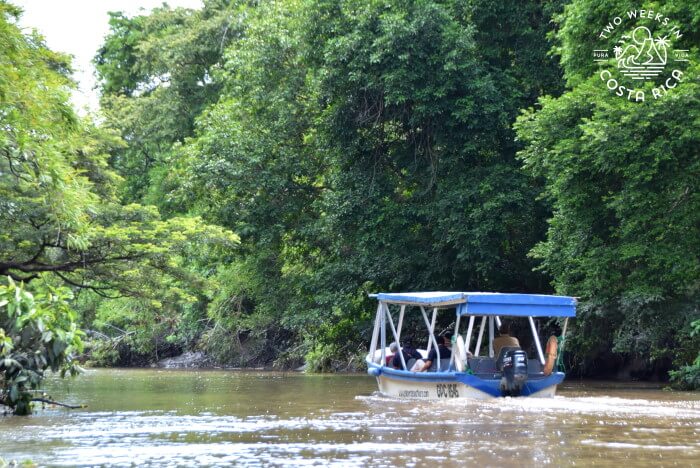
A Cultural Trip Through Guanacaste
Our tour of Palo Verde National Park began one morning in Tamarindo. After breakfast, our family loaded into a shuttle van and headed off. Our driver, Jose, and guide, David, were eager to start the day.
As we left town and got onto the long flat roads of Guanacaste, David began introducing us to the area. He explained about the abundant agricultural fields surrounding us and how they have changed over time. Once used by small family farms to grow fruits and vegetables, then for cattle farming, this land has mostly transitioned into sugar cane crop.
The drive out to the wetlands was about 1.5 hours, but we stayed entertained. In addition to the history we learned, we stopped several times to see birds and wildlife along the rural roads. Some highlights were a Yellow-billed Cuckoo (bird) and a family of coati (a racoon-like animal with a long snout and tail).
To further break it up, we stopped in a small village to use the restroom. Here, we got to see some locally made Chorotega-style (indigenous) pottery. The village was very authentic with several wooden homes and even some horses on the streets.
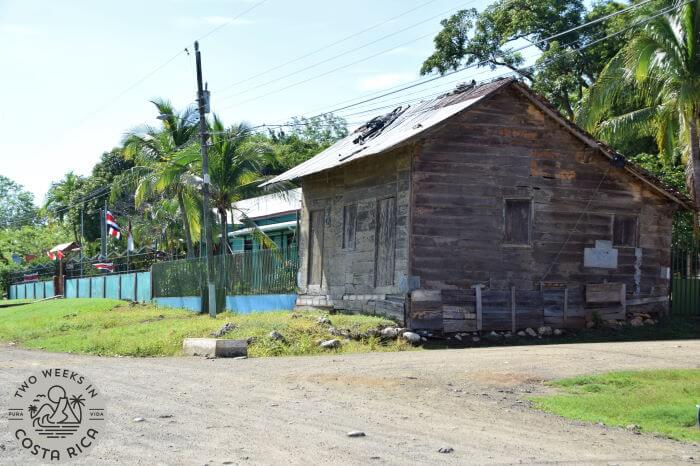
Arriving at Palo Verde National Park
After a short drive more in the van, we arrived at the wide river.
The Tempisque River stretches for miles, winding and connecting with other streams as it gets bigger. The river is inside one of Costa Rica’s biggest watersheds, getting runoff even as far away as Arenal Volcano.
The river and surrounding wetlands stay green and wet all year-round. This is why many animals call it home and even more visit during the driest months.
Eventually, the mighty Tempisque River pours into the Gulf of Nicoya and Pacific Ocean. This makes it an important fish breeding ground as well.
As we boarded a long skinny boat, David explained that while the docks didn’t look like much today, at one time, this was a booming area.
Most of the agricultural products that grew in Guanacaste used to pass through here. Before highways, the goods were loaded onto barges and boats, then floated down the river. Ultimately, they went to Puntarenas, one of Costa Rica’s largest ports, where they could be shipped to other areas of the country or exported.
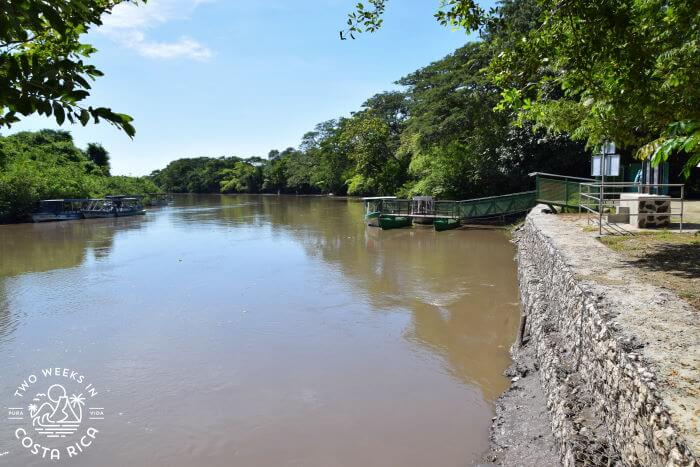
A Boat Tour of Palo Verde National Park
The highlight of our day was the boat tour. From the moment we pushed off the dock, we began to see wildlife.
First, it was a giant iguana sunning itself in a tree, then a troop of white-faced monkeys eating fruit off the branches. There were at least 30 in the family!
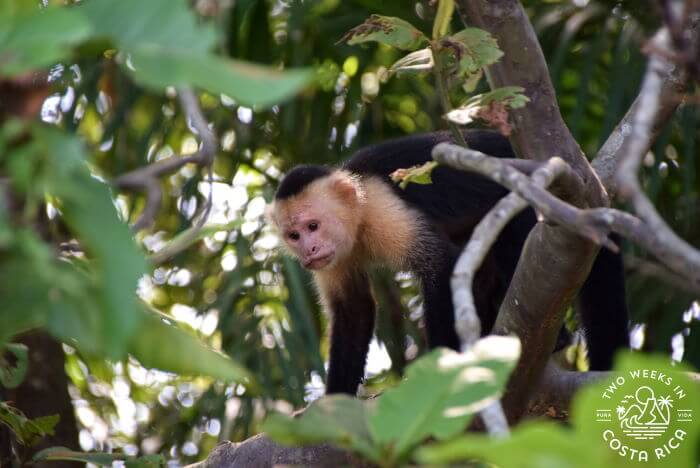
The boat glided through the murky water over to the opposite shore then down a narrower branch of the river. Everywhere we went, David pointed out different creatures. There were giant grasshoppers the size of your hand, a Jesus Christ Lizard (can run across the water), a family of bats sleeping on a tree trunk, and birds all around.
Some of the birds we identified were the White Ibis and her two babies, a Little Blue Heron, a Great Blue Heron, and a Ringed Kingfisher.
We knew one bird was an extra special sighting, since David got excited about it. It was a Gray-headed Kite and her fledgling, apparently uncommon to see.
Along the banks of the river and lurking in the shallows, we also saw several crocodiles. David pulled the boat up close to a baby hiding in the sticks so that we could get a picture. We saw some larger crocs swimming in the deeper water too, poking their eye just above the waterline.
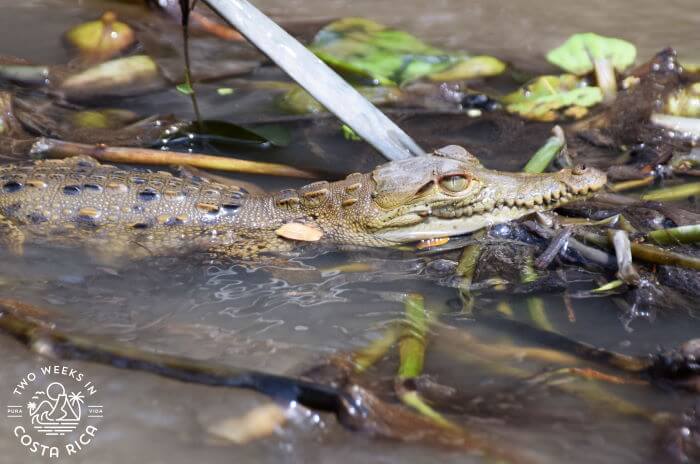
Overall, the boat portion of our tour lasted about two hours. We felt like we saw so much during the ride. On the way back to the docks, David even let our oldest son steer the boat. He was thrilled.
An Authentic Costa Rican Meal and Farm Visit
Interesting Sites at the Farm
After the boat tour, Jose, our driver, was waiting. The air-conditioned van felt amazing after visiting the steamy wetlands. But we weren’t just heading back to the hotel. Our next stop was a farm where we would sit down for an authentic Costa Rican meal.
When we arrived at the farm, we could tell it would be a cultural experience. The family was stoking the wood stove and beginning to cook rice in a shiny pot on top. David introduced us and said he would show us around the property while the food was being prepared.
There was a lot to see.
First, we walked through a sort of museum. It was an old farmhouse built from faded wooden planks. Inside was a bed, rocking chair, and some dusty oil lanterns. This, explained David, was a traditional house in the area back when most of the trade went through the river.
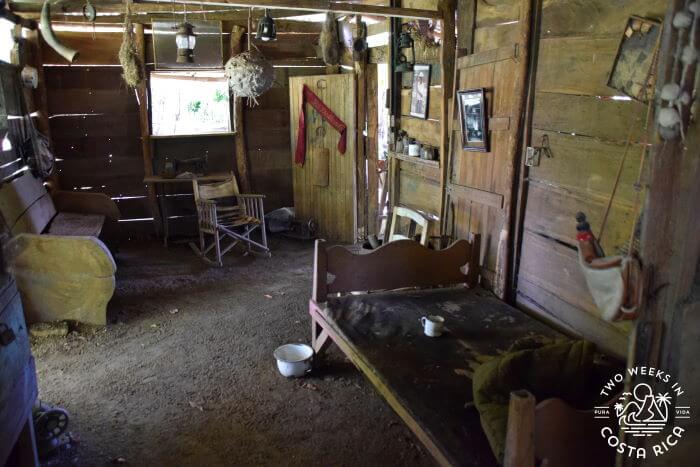
Along the walls of the house were some old photos. One was of some barges floating down the river we had been on. Another was of a crocodile parade held each year in town. David explained that before crocodiles were protected, there was a prize for the person who caught the biggest one. Then that croc was paraded through town like a trophy. Sometimes they were more than 20 feet (6 meters) long.
After, we toured more of the farm and let our kids meet some of the animals like chickens and a giant pig. Our oldest son was excited to be able to ride one of the horses.
A Traditional Lunch
With lunch ready, we sat down at the simple wooden table. The meal consisted of homemade corn tortillas and stewed chicken, rice, and black beans. There was also a salad and some freshly squeezed fruit juice. Everything was served in the traditional clay bowls that we had learned about earlier in the day. And everything was delicious.
After the meal, they brewed us some Costa Rican coffee using a traditional chorreador.
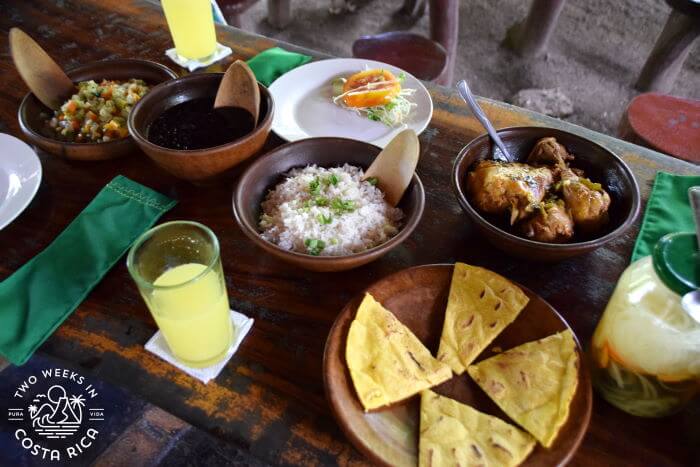
Milling Sugar Cane
Filled up, David took us to see one last thing on the farm, a traditional sugar cane mill.
An old man explained how it worked while David translated. Then it was time to try it out.
He handed us some sugar cane stalks and told us to put them into the grinder in the center. When we pushed the large wooden handles in a circle around the machine, it began crushing the reeds and pouring the juice into a pitcher.
We all got a taste of the sweet juice and talked about how hard it was to push. The old man told us that usually they have a horse do it, but that tourists work well too!
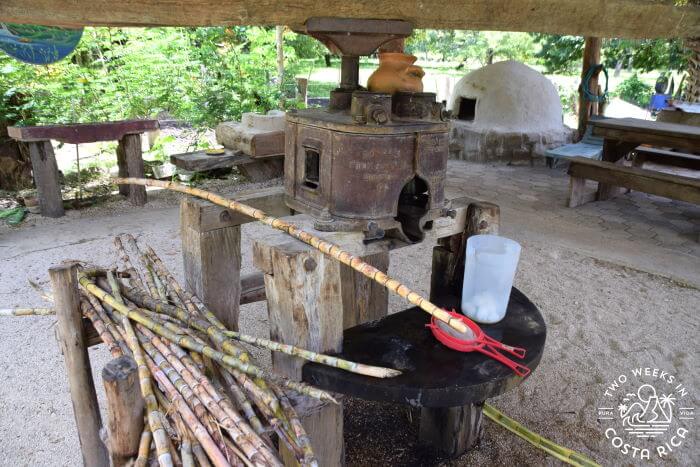
Ending the Day
Our tour ended with a nice goodbye to David and Jose. Though it had been a long day, it was filled with some interesting history and a lot of great wildlife. We highly recommend experiencing it for yourself.
Palo Verde National Park Tour Information
Cost (2024)
$116 per person adults. $93 per person children ages 5-10. Children under 5 are free. Rates plus 13% tax.
Minimum Age
None. Suitable for anyone.
Offered
Pick up points available in northern Guanacaste Province (Tamarindo/JW Marriott, Flamingo, Conchal, Potrero, Ocotal, Playas del Coco, Playa Hermosa, Playa Panama, Papagayo, RIU).
Pick up Time
7:30 a.m. (may vary depending on exact location)
Duration
7 hours door-to-door from your hotel (approximate)
Tour Includes
Bilingual naturalist guide, traditional lunch, water, park entrance fee, and round-trip transportation from your hotel or vacation rental in Guanacaste.
Booking a Tour of Palo Verde National Park
Click below to go to our booking system where you can reserve your tour. We will email you once the reservation is confirmed with the operator. Booking through us costs the same and helps our website. Thank you for your support!
Have a question about visiting Palo Verde National Park? Ask us in the comments below.
Looking for more information to plan your trip to Costa Rica? Check out these posts:
Rincon de la Vieja National Park: Volcanic Vents and Tropical Forest – This is another popular day trip from Guanacaste’s beaches. Hike to see volcanic steam vents, bubbling mud pots, and more.
Santa Rosa National Park: Hiking and History in Guanacaste – Explore the dry forest ecosystem and learn about the history of the Guanacaste region at Santa Rosa National Park.
Oropendola Waterfall: An Easy-To-Access Waterfall In Guanacaste – This beautiful cascade is a short walk down a trail and cool hanging bridge.


